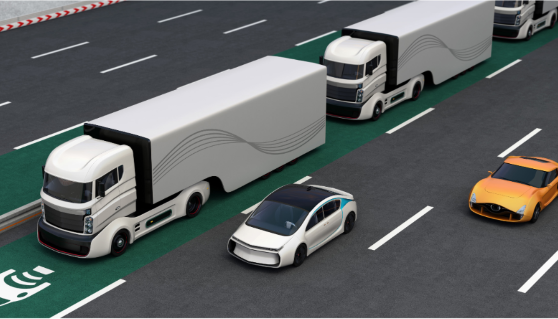
Imagine full truck loads with a pick-up in Oss, The Netherlands and delivery in Lyon, France. A local driver moves the trailer from the pick-up address in Oss to a designated hub near the highway. The trailer then autonomously moves (electric) from this hub to a designated hub in Lyon. Rosa Thuis had a critical look at the possibilities of autonomous semitrucks.
AUTONOMOUS SEMITRUCKS
In 2019, the highest selling car in the Netherlands was the Tesla Model 3. It sold 29.922 units. Two of the strongest features of the Tesla Model 3 are that it is electric and it has autopilot. Tesla is not alone in including these strong selling points – BMW, Mercedes Benz, Nissan and Volvo also sell cars with these features. However, auto pilot semi trucks have not yet hit the market.
On 6 September 2019, Vos Logistics outlined four main topics that will impact the industry in the near future as part of its 75th anniversary, ‘Imagine Vos Logistics 100!’. These topics are:
Sustainability through energy transition, Digitalization and data analytics, The impact of e-commerce on supply chains, andHow autonomous driving and robotics will impact the way of working in logistics.
The development of an auto pilot semi-truck will be a major step in digitizing the trucking industry and be a main driver for other fundamental changes in our industry. Some truck manufacturers and a number of start-ups are in the process of developing autonomous semi-trucks. This paper will examine autonomous trucking and look at how it will change the trucking industry.
What is an autonomous driving vehicle?
An autonomous vehicle is a vehicle that is able to operate without human interaction. This means that no driver is needed. This may mean that there isn’t even a space for a driver in the vehicle. There are six levels of automation, with level ‘0” being a vehicle that requires full human control. The other 5 levels are explained in the following info graphic:
- Driver Assistance
The ability to support the driver with either steering,
accelerating or breaking. - Partial Automation
Able to oversee the three activities in some conditions,
however, complete attention is required. - Conditional Driving Automation
The vehicle can perform most tasks, but human
override is still required. - High Driving Automation
The vehicle is able to perform all driving tasks, however
geofencing is required and human override is still possible. - Full Driving Automation
The vehicle performs all the driving tasks and no human
attention or interaction is needed.
Solutions without drivers?
Autonomous semi-trucks are already being developed and tested. Whereas each company has a different strategy, they share the goal of developing a semi-truck that doesn’t require a driver to execute all the tasks. Volvo is currently developing Vera, a self-driving electric vehicle with Level 5 autonomy, where there is no cabin for a driver. The business model of this particular vehicle is to operate on a predefined route, in order to create seamless transportation. Volvo is testing Vera in Goteborg on a run that involves transporting goods from a logistics centre to a port terminal.
Einride is another Swedish company developing an autonomous truck. Like Vera, the Einride test truck has no space for a driver and includes certain driving actions controlled by a human by remote control. Whereas Vera is mainly focused on short-haulage, the Einride pod has the ability to carry out different types of transportation. For example, haulage of high-volume shipments, urban deliveries and distribution. The main difference between the two, is that the Einride vehicle still needs remote driver assistance.
Innovations that still require drivers
Not all developers are planning on producing vehicles with Level 5 autonomy, most are aiming for Level 4. Companies such as Embark, Waymo, Tu Simple, Kodiak Robotics, Plus.ai, AutoX and Paccar are planning on developing a semi-truck where a driver is still needed. Most of these companies are developing a vehicle that is able to drive autonomously from A to B while the option for a human to override is still possible, but not mandatory.
For some companies, the strategy is more specific. For example, at Embark, the business model is to develop autonomous vehicles that can drive from one hub to another hub. This means that the semi-truck would mainly drive on the highway, rather than also on the smaller roads to a particular customer location. Then, Tu Simple and Plus.ai extend the business model in a way that the semi-trucks will be enhanced with 360-degree awareness in any type of weather and with a system that can detect obstacles up to either 1,000 or 1,600 meters away. This does not change the way the vehicle drives, but how the system behind it works. Aurora Innovation, Ike, AutoX and Hyundai specifically focus on the hardware, software and data services that allow vehicles to be autonomous. So, as shown, there are many companies with different strategies seeking to fundamentally change the trucking industry.
Probably the most talked about model under development is the Tesla autonomous semi-truck. It will follow the Level 3 autonomy, while others mainly focus on Level 4. The Tesla Semi will therefore enhance the same opportunities for truck drivers as it does for the drivers of the Model 3 car. Lastly, Pronto.ai is offering semi-trucks with Level 2 autonomy, where the vehicle has full adaptive cruise control, proactive lane centering and automatic emergency braking. Another interesting feature that many of these companies are working on is an autonomous vehicle that is electric or hydrogen based.
Benefits from an autonomous driving semi-truck
The fact that so many companies are developing and planning to start producing autonomous semi-trucks prompts the question – why are they? One reason that autonomous trucks are interesting to carriers is increased road safety. Each day in The Netherlands alone there are 17 semi-trucks involved in an accident or standing on the side of the road with problems. Between 2009 and 2018 there were, on average, 80 traffic deaths a year where a semi-truck was involved. With autonomous trucking there would be no human errors stemming from using devices or falling asleep while driving. These errors would be eliminated by the new systems. However before autonomous vehicles are able to increase travel safety, they have to be tested extensively. It is only once it is sure that they will make no mistakes that the vehicle could increase traffic safety.
In addition to safety, cost and travel time can be decreased. As human involvement is not necessary for Level 4, the necessary breaks required would be limited. At Level 5, drivers are only needed for certain times on a remote location and not inside the trucks. The truck is able to anticipate to the traffic quicker than humans, so the driving becomes smoother. This means that autonomous trucking has the potential to decrease both driver and fuel costs. Labour and fuel together make up around 80% of the total costs for logistics operations. Logistics service providers are looking at every possibility to reduce these costs. And as mentioned earlier, the combination of developing an autonomous semi-truck that can run on either hydrogen or BEV could really change the cost model of the truck.
As autonomous trucks drive more smoothly, the possibility of driving with a battery are increased. The truck’s smooth drive means the battery can be used to full capacity and won’t need to be charged. This way, the truck retains the crucial benefit of not having to stop very often.
Ideally, autonomous trucks will drive between hubs during the night. The chance of disruption is then lower because traffic is lighter. This would work well in combination with either hydrogen or BEV, greatly reducing noise as well as emissions. Together, these newly developed techniques could therefore mean that autonomous driving has the potential to increase the road safety, decrease costs and limit travel time.
Time to market
While this vision for the future almost sounds too good to be true, companies are actually already planning to market the autonomous trucks soon. Most American developers are already in the testing stage. For example, at the beginning of 2020, Waymo announced that the testing would start in Texas, New Mexico, Arizona and California. This region is popular for testing self-driving trucks, as the weather and roads are favorable. Embark and Kodiak are testing and driving there as well. Kodiak has already started with the first commercial deliveries, and has eight autonomous vehicles within its fleet. Subsequently, Tu Simple has completed five round trips within a two-week period, hauling USPS trailers for more than 1,000 miles.
While most companies developing autonomous semi-trucks are located in the Americas, Hyundai is developing trucks in South Korea, AutoX is developing autonomous trucks in Hong Kong and Volvo and Einride are based in Sweden. Before autonomous trucks are launched in The Netherlands, the testing phase and introduction phase will first be completed in the home country of the truck company. However, some companies have indicated that they would like to launch their trucks straight onto the commercial market, which means that the trucks could be here sooner. The exact timing, however, is not yet known.
Imagine autonomous driving at Vos Logistics
Depending on the solutions offered, transport companies already benefit from technical solutions being used in autonomous vehicles. Or looking at it the other way around, autonomous vehicles will benefit from features currently in use. Think: adaptive cruise control, automatic route planning and motor management systems to optimize driving or camera’s replacing mirrors. More techniques will enter into the cabin like lidar and autonomous steering. These features support drivers and mean increased safety, economy and efficiency. The next step might be that the driver’s role changes to simply support some parts of the drive and will be replaced in some parts of the transport route.
To give you an idea, imagine full truck loads with a pick-up in Oss, The Netherlands and delivery in Lyon, France. A local driver moves the trailer from the pick-up address in Oss to a designated hub near the highway. The trailer then autonomously moves (electric) from this hub to a designated hub in Lyon. Ideally, this would happen during the night, avoiding congestion. The next morning a local French truck picks up the trailer from the hub in Lyon to perform the last mile for delivery.
Utopian or realistic?
As Steven Covey suggests, it’s best to ‘begin with the end in mind’. So let’s consider for a moment that this is picture is a realistic one. What is needed to get to this point? We have already elaborated on the technical aspects in this white paper. To make this ambition a reality, we also need to anticipate issues in areas such as infrastructure, transport management and monitoring systems, organizational changes, social impact and acceptance, European legislation, liability and insurance and last but not least, the cost of transportation.
There are lots of reasons why this development will be of great benefit to society from a social, environmental and business point of view. On the other hand, it’s likely that it will feed opposition and resistance from different interest groups. Managing this resistance in a realistic and useful timeframe is probably the most challenging part of realizing this evolution.
About Rosa Thuis
 Rosa Thuis (22) is a fourth year International Logistics Engineering student at Breda University of applied sciences, where she will graduate from in July 2021. Rosa finds technology and innovation the most interesting topics, specifically combined with logistics. For example, using block chain within the supply chain, improving warehousing by AI or AR, and innovations as autonomous driving. Besides this intern-ship for Vos Logistics, Rosa has interned for DHL Supply Chain Thailand and Nakheel Oman Development Company. During her last studying year, she is doing an Exchange at NUI Galway and will start her final internship in February. For the upcoming years, Rosa’s goal is to pursue a Master’s degree in technology and innovation. However, first she would like to gain more experience in the working field.
Rosa Thuis (22) is a fourth year International Logistics Engineering student at Breda University of applied sciences, where she will graduate from in July 2021. Rosa finds technology and innovation the most interesting topics, specifically combined with logistics. For example, using block chain within the supply chain, improving warehousing by AI or AR, and innovations as autonomous driving. Besides this intern-ship for Vos Logistics, Rosa has interned for DHL Supply Chain Thailand and Nakheel Oman Development Company. During her last studying year, she is doing an Exchange at NUI Galway and will start her final internship in February. For the upcoming years, Rosa’s goal is to pursue a Master’s degree in technology and innovation. However, first she would like to gain more experience in the working field.
About Vos Logistics
Vos Logistics is a specialist in a wide range of transport and logistics services. Through a network of 30 group-owned locations, the company is active throughout Europe. Solutions offers customer-specific logistics solutions, from forwarding, warehousing, value-added services and distribution to full supply chain solutions in which Vos Logistics assumes management of all of the customer’s goods flow. In the bulk and volume (Mega and High Volume) transport markets, Vos Logistics is one of the largest road hauliers in Europe. With 3,000 employees, it operates a modern fleet of 1,400 trucks, 4,000 loading units and 340,000 m2 of storage space.
Bibliography
Andersson, P., & Ivehammar, P. (2019). Benefits and Costs of Autonomous Trucks and Cars. Linköping, Sweden: Linköping University.Korosec, K. (2019, August 6). Self-driving truck startup Kodiak Robotics begins deliveries in Texas. Retrieved from TechCrunch: https://techcrunch.com/2019/08/06/self-driving-truck-startup-kodiak-robotics-begin-deliveries-in-texas/Hirsch, J. (2020, August 25). Waymo Begins Testing Autonomous Heavy-Duty Trucks in Texas. Retrieved from Trucks.com: https://www.trucks.com/2020/08/25/waymo-autonomous-truck-tests/Voermans, T. (2019, Juli 27). Record: elke dag 17 vrachtwagens betrokken bij ongeval of met pech op snelweg, vooral bij Eindhoven. Retrieved from ED: https://www.ed.nl/auto/record-elke-dag-17-vrachtwagens-betrokken-bij-ongeval-of-met-pech-op-snelweg-vooral-bij-eindhoven~a343191b/?referrer=https%3A%2F%2Fwww.google.com%2FSWOV. (2020, April 3). Factsheet; Vracht- en bestelauto’s. Retrieved from SWOV: https://www.swov.nl/feiten-cijfers/factsheet/vracht-en-bestelautosFletcher, S. (2020, September 25). Why autonomous trucks are carrying serious weight. Retrieved from TechHQ: https://techhq.com/2020/09/why-autonomous-trucks-are-carrying-serious-weight/Jacobs, F. (2020, April 30). Tesla and Audi move to autonomy at different levels. Retrieved from Global Fleet: https://www.globalfleet.com/en/autonomous/europe/features/tesla-and-audi-move-autonomy-different-levels?a=FJA05&t%5B0%5D=Audi&t%5B1%5D=Tesla&t%5B2%5D=Autonomous&curl=1TWI. (n.d.). What is an autonomous vehicle. Retrieved from TWI: https://www.twi-global.com/technical-knowledge/faqs/what-is-an-autonomous-vehicleHyperdrive. (2020, May 15). The State of the Self-Driving Car Race 2020. Retrieved from Bloomberg: https://www.bloomberg.com/features/2020-self-driving-car-race/Reiter, J. C. (2020, September 28). New York City Truck Accident Lawyer Update: Autonomous Trucks Are Here. Are They Safe? Retrieved from Global News Wire: https://www.globenewswire.com/news-release/2020/09/28/2099638/0/en/New-York-City-Truck-Accident-Lawyer-Update-Autonomous-Trucks-Are-Here-Are-They-Safe.htmlDFDS. (n.d.). The impact of self-driving trucks. Retrieved from DFDS: https://www.dfds.com/en/about/insights/newsletters/self-driving-trucksBlanco, S. (2020, April 7). Einride’s Autonomous Pod Trucks Now Schlepping Around Sweden. Retrieved from Forbes: https://www.forbes.com/sites/sebastianblanco/2020/04/07/einrides-autonomous-pod-trucks-now-schlepping-around-sweden/Logistiek.nl. (2020, September 17). Chauffeurstekort: zo pakken de Belgen het aan. Retrieved from Logistiek.nl: https://www.logistiek.nl/carriere-mensen/nieuws/2020/09/chauffeurstekort-zo-pakken-de-belgen-het-aan-101174942Redwood Logistics. (n.d.). How Autonomous Trucking Will Affect the Trucking Industry. Retrieved from Redwood Logistics: https://www.redwoodlogistics.com/autonomous-trucking-affect-trucking-industry/
Please note that citing from this article is appreciated with the connotation of the source and author.
Source www.voslogistics.com




.jpg)






